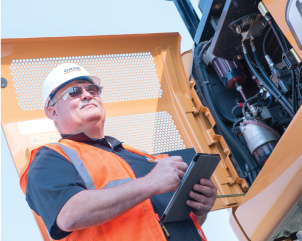Tips for Choosing the Right Wheel Loader Bucket
Wheel loaders are staples on a wide variety of jobsites, including construction, road building, aggregate processing, and many others. These machines move large volumes of dirt, rocks, snow, gravel, and almost anything else you need to load, transfer, or remove. Choosing the best wheel loader bucket for your specific project is key for ensuring the job is completed efficiently. To help you use the right bucket for your job, we put together everything you need to take into account when choosing the one you’ll use.
Consider your material
Wheel loaders are designed to dig, load, and dump materials that are heavy and abrasive. The specific types of material you’re working with is the primary factor driving which wheel loader bucket you use. For loose objects like sand, gravel, and topsoil, we recommend choosing a general purpose bucket with a larger capacity and curved edges. A light material bucket is best for carrying large volumes of lower density material like snow or mulch. If you’re loading high density rocks or concrete on quarry or mining operations, a rock bucket is your best choice. You can also use a rock bucket for large earthmoving projects, including site development and road construction.
Often, the name of a specific wheel loader bucket tells you what type of material it is supposed to handle. For example, names like heavy duty, abrasion, general purpose, light material bucket, rock bucket reveal the best use for each one.
Determine whether you’re loading or digging
If you’re primarily loading rocks, dirt, or other material, we recommend choosing a high capacity wheel loader bucket with a smooth profile, big opening angle, and straight cutting edge. However, if your primary task is digging out material, then using a bucket with high penetration teeth and greater breakout force will work best.
Match bucket size and machine power
A larger wheel loader bucket does not always mean increased production. When thinking about how large the bucket should be, you first need to consider the size and power of your wheel loader and the size of your trucks and hoppers. Using a wheel loader bucket that pushes your equipment beyond its suggested capacity will increase wear, shorten component life, and cause expensive, unexpected downtime.
- Look in your wheel loader owner’s manual for the bucket size and maximum tipping load
- Take into account how big your truck or hopper will be, and determine how many loads you’ll be required to move every day
- Use a wheel loader bucket that can move the necessary volume of material but that doesn’t overload your equipment
Choose the right wheel loader bucket features
After determining what material you’re digging or loading and the best sized bucket, next you should consider additional design features that can save you time or minimize wear and tear. Here are some examples of valuable wheel loader bucket features:
- Curved side plates and integrated spill guards will increase material retention
- Wear protectors and extra guarding can minimize damage and lengthen bucket life
- Using quick couplers you can change buckets easily, so it’s an important feature if you need to change the buckets often
- With bolt-on teeth and cutting edges you can use the same bucket for different types of jobs
- Longer bucket floors will speed up your cycles
If you have any questions about choosing the right wheel loader bucket, or about wheel loaders in general, contact our team today.

